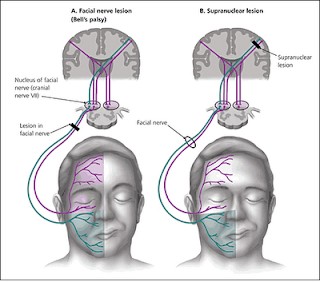Mar 07, 2016 · Because speech, mastication, and expression of moods and emotions are based on the ability to move facial musculature—be it voluntary or involuntary—successful treatment of facial nerve paralysis is a vital concern.



SYNONYMS: Cranial nerve seven (VII), Nervus facialis COURSE OF FACIAL NERVE Supranuclear pathways 1. Somatomotor cortex: controlling motor component of facial nerve lies in precentral gyrus (Broadmann area 4,6,8) 2.

The facial nerve is one of the key cranial nerves with a complex and broad range of functions. Although at first glance it is the motor nerve of facial expression which begins as a trunk and emerges from the parotid gland as five branches (see f

Vagus nerve: Vagus nerve, longest and most complex of the cranial nerves. The vagus nerve runs from the brain through the face and thorax to the abdomen. It is a mixed nerve that contains parasympathetic fibres.
The medical information on this site is provided as an information resource only, and is not to be used or relied on for any diagnostic or treatment purposes.
The nerves of the scalp, face, and side of neck. Details; From: facial nerve: Innervates: cheek: Identifiers; Latin: rami buccales nervi facialis
by Paulette Marie Gillig, MD, PhD, and Richard D. Sanders, MD Dr. Gillig is Professor of Psychiatry and Faculty of the Graduate college, Department of Psychiatry, Wright State University, Dayton, Ohio; Dr. Sanders is Associate Professor, Departments of Psychiatry and Neurology, Boonshoft college of Medicine, Wright State University, and Ohio VA




The facial nerve, CN VII, is the seventh paired cranial nerve. In this article, we shall look at the anatomical course of the nerve, and the motor, sensory and parasympathetic functions of its terminal branches.
Cavalier King Charles Spaniels’ Miscellaneous Disorders. List of Disorders; Research News; What You Can Do; Veterinary Resources; Occasionally we discover veterinary journal articles about one or a few cavalier King Charles spaniels being diagnosed with veterinary disorders rarely found in the breed.
Plan of the facial and intermediate nerves and their communication with other nerves. (“Nucleus of Facial N.” labeled at upper left.)
